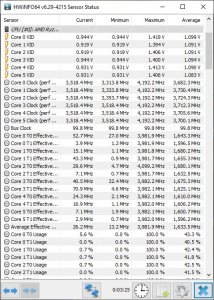thesmokingman
Supreme [H]ardness
- Joined
- Nov 22, 2008
- Messages
- 6,617
Saw this in my firefox news feed and was posting on it at TPU.
Some boards are reporting false power draws to Ryzen cpus.
https://www.hwinfo.com/forum/thread...er-reporting-deviation-metric-in-hwinfo.6456/
Get your beta here.
https://www.fosshub.com/HWiNFO.html
Get the latest beta and fire up Cinebench and test your board out. Don't forget whatever power draw limits you raised already and undo them.
Also the deviation reporting only applies to full load.
Some boards are reporting false power draws to Ryzen cpus.
https://www.hwinfo.com/forum/thread...er-reporting-deviation-metric-in-hwinfo.6456/
Get your beta here.
https://www.fosshub.com/HWiNFO.html
Ryzen CPUs for AM4 platform rely on external, motherboard sourced telemetry to determine their power consumption. The voltage, current and power telemetry is provided to the processor by the motherboard VRM controller through the AMD SVI2 interface. This information is consumed by the processors power management co-processor, that is responsible for adjusting the operating parameters of the CPU and ensuring, that neither the CPU SKU, platform or infrastructure specific limits are being violated.
The weakness of this method is, that the telemetry essentially uses an undefined scale for the current (and hence power) measurements. This means that the motherboard VRM controller will send an integer between 0 - 255 to the CPU, and based the reference value known by the co-processor firmwares, this integer is converted to a figure, that represents a physical current drawn by the CPU. Based on the accurately known current flow and the voltage, it is possible to calculate to CPU power draw in Watts (V * I).
Get the latest beta and fire up Cinebench and test your board out. Don't forget whatever power draw limits you raised already and undo them.
HWiNFO will display "Power Reporting Deviation" metric under the CPUs enhanced sensors. The displayed figure is a percentage, with 100.0% being the completely unbiased baseline. When the motherboard manufacturer has both properly calibrated and declared the reference value, the reported figure should be pretty close to 100% under a stable, near-full-load scenario. A ballpark for a threshold, where the readings become suspicious is around ±5%. So, if you see an average value that is significantly lower than ~ 95% there is most likely intentional biasing going on. Obviously, the figure can be greater than 100%, but for the obvious reasons it rarely is
Also the deviation reporting only applies to full load.
As stated before, this metric is only valid during a relatively stable near-full-load condition
Last edited:
![[H]ard|Forum](/styles/hardforum/xenforo/logo_dark.png)


